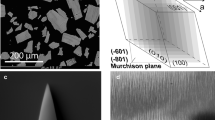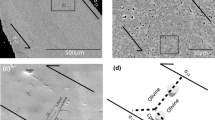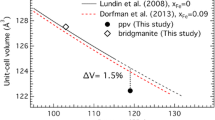Abstract
The feldspar minerals occur in a wide variety of lithologies throughout the Solar System, often containing a variety of chemical and structural features indicative of the crystallization conditions, cooling history and deformational state of the crystal. Such phenomena are often poorly resolved in micrometre-scale analyses. Here, atom probe tomography (APT) is conducted on Ca-rich (bytownite) and Na-rich (albite) plagioclase reference materials, experimentally exsolved K-feldspar (sanidine), shock-induced plagioclase glass (labradorite-composition), and shocked and recrystallized plagioclase to directly test the application of APT to feldspar and yield new insights into crystallographic features such as amorphisation and exsolution. Undeformed plagioclase reference materials (Amelia albite and Stillwater bytownite) appear chemically homogenous, and yield compositions largely within uncertainty of published data. Within microstructurally complex materials, APT can resolve chemical variations across a ~ 20 nm wide exsolution lamella and define major element (Na, K) diffusion profiles across the lamella boundaries, which appear gradational over a ~ 10 nm length scale in experimentally exsolved K-feldspar NNPP-04b. The plagioclase glass within the Zagami shergottite shows no heterogeneity in the distribution of major elements, although the enrichment of Fe, Mg and Sr in the bulk microtip points to at least minor incorporation of surrounding phases (pyroxene), and with that supports a shock-melt origin for the glass (maskelynite). The recrystallization of feldspar during post-shock annealing, such as in poikilitic shergottite NWA 6342, appears to induce a range of chemical nanostructures that locally effect the composition of the material. These findings demonstrate the ability of APT to yield new insights into nanoscale composition and chemical structures of alumniosilicate phases, highlighting an exciting new avenue with which to analyse these key rock-forming minerals.






Similar content being viewed by others
References
Anderson GM, Burnham CW (1983) Feldspar solubility and the transport of aluminium under metamorphic conditions. Am J Sci 283:283–297
Artemieva N, Ivanov B (2004) Launch of Martian meteorites in oblique impacts. Icarus 171(1):84–101
Bischoff A, Stoeffler D (1992) Shock metamorphism as a fundamental process in the evolution of planetary bodies: information from meteorites. Eur J Mineral 4(4):707–755
Borg LE, Edmunson JE, Asmerom Y (2005) Constraints on the U–Pb isotopic systematics of Mars inferred from a combined U–Pb, Rb–Sr, and Sm–Nd isotopic study of the Martian meteorite Zagami. Geochim Cosmochim Acta 69(24):5819–5830
Chen M, El Goresy A (2000) The nature of maskelynite in shocked meteorites: not diaplectic glass but a glass quenched from shock-induced dense melt at high pressures. Earth Planet Sci Lett 179(3):489–502
Daly L, Bland PA, Tessalina S, Saxey DW, Reddy SM, Fougerouse D, Rickard WDA, Forman LV, La Fontaine A, Cairney JM, Ringer SP, Schaefer BF, Schwander D (2018) Defining the potential of nanoscale Re–Os isotope systematics using atom probe microscopy. Geostand Geoanal Res. https://doi.org/10.1111/ggr.12216
Delavault H, Dhuime B, Hawkesworth CJ, Cawood PA, Marschall H (2016) Tectonic settings of continental crust formation: insights from Pb isotopes in feldspar inclusions in zircon. Geology 44(10):819–822
Deuser WG, Hertzog LF (1962) Rubidium – strontium age determinations of muscovites and biotites from pegmatites of the Blue Ridge and Piedmont. J Geophys Res 67:1997–2004
Drake MJ, Weill DF (1975) Partition of Sr, Ba, Ca, Y, Eu2+, Eu3+, and other REE between plagioclase feldspar and magmatic liquid: an experimental study. Geochim Cosmochim Acta 39(5):689–712
Ferrière L, Brandstätter F (2005) What is maskelynite? back to the original description and thin sections in which it was first described. In: 78th annual meeting of the meteoritical society (abstract #5184)
Fritz J, Wünnemann K, Greshake A, Fernandes VASM, Boettger U, Hornemann U (2011) Shock pressure calibration for lunar plagioclase. In: Lunar and planetary science conference, vol 42, p 1196
Gault B, Moody MP, Cairney JM, Ringer SP (2012) Atom probe microscopy, vol 160. Springer Science & Business Media, Berlin
Giletti BJ (1991) Rb and Sr diffusion in alkali feldspars, with implications for cooling histories of rocks. Geochim Cosmochim Acta 55(5):1331–1343
Grove TL (1977) Structural characterization of labradorite–bytownite plagioclase from volcanic, plutonic and metamorphic environments. Contrib Mineral Petrol 64(3):273–302
Grove TL, Baker MB, Kinzler RJ (1984) Coupled CaAl–NaSi diffusion in plagioclase feldspar: experiments and applications to cooling rate speedometry. Geochim Cosmochim Acta 48(10):2113–2121
Heuer AH, Lally JS, Christie JM, Radcliffe SV (1972) Phase transformations and exsolution in lunar and terrestrial calcic plagioclases. Philos Mag 26(2):465–482
Hibbard MJ (1981) The magma mixing origin of mantled feldspars. Contrib Mineral Petrol 76(2):158–170
Jaret SJ, Woerner WR, Phillips BL, Ehm L, Nekvasil H, Wright SP, Glotch TD (2015) Maskelynite formation via solid-state transformation: evidence of infrared and X-ray anisotropy. J Geophys Res Planets 120(3):570–587
Jessberger EK, Ostertag R (1982) Shock-effects on the K–Ar system of plagioclase feldspar and the age of anorthosite inclusions from North-Eastern Minnesota. Geochim Cosmochim Acta 46(8):1465–1471
Kizovski T (2017) Detailed mineralogical and petrological analysis of Martian shergottite NWA 6342. Master’s thesis, University of Toronto
Lee MR, Waldron KA, Parsons I (1995) Exsolution and alteration microtextures in alkali feldspar phenocrysts from the Shap granite. Mineral Mag 59(1):63–78
Lin TH, Yund RA (1972) Potassium and sodium self-diffusion in alkali feldspar. Contrib Mineral Petrol 34(3):177–184
Lorimer GW, Champness PE (1973) The origin of the phase distribution in two pathetic alkali feldspars. Philos Mag 28(6):1391–1403
Marti K, Kim JS, Thakur AN, McCoy TJ, Keil K (1995) Signatures of the Martian atmopshere in glass of the Zagami meteorite. Science 267(5206):1981–1984
McCoy TJ, Taylor GJ, Keil K (1992) Zagami: product of a two-stage magmatic history. Geochim Cosmochim Acta 56(9):3571–3582
McEnroe SA, Robinson P, Miyajima N, Fabian K, Dyar D, Sklute E (2016) Lamellar magnetism and exchange bias in billion-year-old titanohematite with nanoscale ilmenite exsolution lamellae: I. Mineral and magnetic characterization. Geophys J Int 206(1):470–486
McGuire AV, Francis CA, Dyar MD (1992) Mineral standards for electron microprobe analysis of oxygen. Am Mineral 77:1087–1087
McLeod CL, Brandon AD, Fernandes VA, Peslier AH, Fritz J, Lapen T, Irving AJ (2016) Constraints on formation and evolution of the lunar crust from feldspathic granulitic breccias NWA 3163 and 4881. Geochim Cosmochim Acta 187:350–374
Milton DJ, De Carli PS (1963) Maskelynite: formation by explosive shock. Science 140(3567):670–671
Norberg N, Harlov D, Neusser G, Wirth R, Rhede D, Morales L (2013) Experimental development of patch perthite from synthetic cryptoperthite: microstructural evolution and chemical re-equilibration. Am Mineral 98(8–9):1429–1441
O’Connor JT (1965) A classification for quartz-rich igneous rocks based on feldspar ratios. US Geol Surv Prof Pap B 525:79–84
Ostertag R (1983) Shock experiments on feldspar crystals. J Geophys Res Solid Earth 88:S01
Ostertag R, Stöffler D (1982) Thermal annealing of experimentally shocked feldspar crystals. J Geophys Res Solid Earth 87:S01
Patterson C, Tatsumoto M (1964) The significance of lead isotopes in detrital feldspar with respect to chemical differentiation within the earth’s mantle. Geochim Cosmochim Acta 28(1):1–22
Peterman EM, Reddy SM, Saxey DW, Snoeyenbos DR, Rickard WD, Fougerouse D, Kylander-Clark AR (2016) Nanogeochronology of discordant zircon measured by atom probe microscopy of Pb-enriched dislocation loops. Sci Adv 2(9):e1601318
Pickersgill AE, Osinski GR, Flemming RL (2015) Shock effects in plagioclase feldspar from the Mistastin Lake impact structure, Canada. Meteorit Planet Sci 50(9):1546–1561
Premo WR, Helz RT, Zientek ML, Langston RB (1990) U–Pb and Sm–Nd ages for the stillwater complex and its associated sills and dikes, Beartooth Mountains, Montana: identification of a parent magma? Geology 18(11):1065–1068
Reddy SM, Potts GJ, Kelley SP (2001) 40 Ar/39 Ar ages in deformed potassium feldspar: evidence of microstructural control on Ar isotope systematics. Contrib Mineral Petrol 141(2):186–200
Reddy SM, van Riessen A, Saxey DW, Johnson TE, Rickard WD, Fougerouse D, Chen Y (2016) Mechanisms of deformation-induced trace element migration in zircon resolved by atom probe and correlative microscopy. Geochim Cosmochim Acta 195:158–170
Schärer U, Deutsch A (1990) Isotope systematics and shock-wave metamorphism: II. U–Pb and Rb–Sr in naturally shocked rocks; the Haughton Impact Structure, Canada. Geochim Cosmochim Acta 54(12):3435–3447
Sinkankas J (1968) Classic mineral occurrences: I. Geology and mineralogy of the Rutherford pegmatites, Amelia, Virgina. Am Mineral 53:373–405
Słaby E, Götze J, Wörner G, Simon K, Wrzalik R, Śmigielski M (2008) K-feldspar phenocrysts in microgranular magmatic enclaves: a cathodoluminescence and geochemical study of crystal growth as a marker of magma mingling dynamics. Lithos 105(1):85–97
Steele IM, Smith JV, Raedeke LD, McCallum IS (1981) Ion probe analysis of stillwater plagioclase and comparison with lunar analyses. In: Lunar and planetary science conference, vol 12, pp 1034–1036
Stöffler D, Ostertag R, Jammes C, Pfannschmidt G, Gupta PS, Simon SB, Beauchamp RH (1986) Shock metamorphism and petrography of the Shergotty achondrite. Geochim Cosmochim Acta 50(6):889–903
Stöffler D, Keil K, Edward RD (1991) Shock metamorphism of ordinary chondrites. Geochim Cosmochim Acta 55(12):3845–3867
Stolper EM (1980) Trace elements in Shergottite meteorites: implications for the origins of planets. Earth Planet Sci Lett 42:239–242
Thompson K, Lawrence D, Larson DJ, Olson JD, Kelly TF, Gorman B (2007) In situ site-specific specimen preparation for atom probe tomography. Ultramicroscopy 107(2):131–139
Togashi S, Imai N, Okuyama-Kusunose Y, Tanaka T, Okai T, Koma T, Murata Y (2000) Young upper crustal chemical composition of the orogenic Japan Arc. Geochem Geophys Geosyst 1(11):1–34
Tschermak G (1872) Die Meteoriten von Shergotty und Gopalpur. Wien Math Naturwiss I 65:122–146
Tschermak G (1883) Beitrag zur Klassifikation der Meteoriten. Wien Math Naturwiss I 88:347–371
Tuttle OF, Bowen NL (1958) Origin of granite in the light of experimental studies in the system NaAlSi3O8–KAlSi3O8–SiO2–H2O. Geol Soc Am Mem 74:1–146
Valley JW, Cavosie AJ, Ushikubo T, Reinhard DA, Lawrence DF, Larson DJ, Spicuzza MJ (2014) Hadean age for a post-magma-ocean zircon confirmed by atom-probe tomography. Nat Geosci 7(3):219–223
Valley JW, Reinhard DA, Cavosie AJ, Ushikubo T, Lawrence DF, Larson DJ, Strickland A (2015) Presidential address. Nano-and micro-geochronology in Hadean and Archean zircons by atom-probe tomography and SIMS: new tools for old minerals. Am Mineral 100(7):1355–1377
White LF, Bailey I, Foster GL, Allen G, Kelley SP, Andrews JT, Storey CD (2016) Tracking the provenance of Greenland-sourced, Holocene aged, individual sand-sized ice-rafted debris using the Pb-isotope compositions of feldspars and 40 Ar/39 Ar ages of hornblendes. Earth Planet Sci Lett 433:192–203
White LF, Darling JR, Moser DE, Reinhard DA, Prosa TJ, Bullen D, Martin I (2017a) Atomic-scale age resolution of planetary events. Nat Commun 8:15597
White LF, Darling JR, Moser DE, Reinhard DA, Dunlop J, Larson DJ, Martin I (2017b) Complex nanostructures in shocked, annealed and metamorphosed baddeleyite defined by atom probe tomography. In: Moser D, Corfu D, Reddy S, Darling J, Tait K (eds) Microstructural geochronology: planetary records down to atom scale. Wiley, Hoboken
Yund RA, McLaren AC, Hobbs BE (1974) Coarsening kinetics of the exsolution microstructure in alkali feldspar. Contrib Mineral Petrol 48(1):45–55
Acknowledgements
L.F.W. acknowledges a Hatch postdoctoral fellowship. Atom probe tomography of Martian samples was facilitated by an NSERC Discovery Grant awarded to K.T.T. APT of albite, bytownite and exsolved K-feldspar were performed at EMSL, a national scientific user facility sponsored by the Department of Energy’s Office of Biological and Environmental Research, located at PNNL. PNNL is a multi-program national laboratory operated for the US Department of Energy by Battelle under Contract DE-AC05-76RL01830. L.M.G was supported by an EMSL Wiley Postdoctoral Fellowship. We thank D. Perea for collection of BSE images of the Stillwater Bytownite and Amelia Albite. The authors acknowledge the facilities, scientific and technical assistance from the Canadian Centre for Electron Microscopy (CCEM) at McMaster University, a national facility supported by the Canada Foundation for Innovation under the Major Science Initiative program, NSERC and McMaster University. Desmond Moser and Ivan Barker are thanked for collecting backscatter images of NWA 6342. We thank E. Slaby and L. Daly for constructive reviews, which substantially improved this manuscript, and O. Müntener for editorial handling.
Author information
Authors and Affiliations
Corresponding author
Additional information
Communicated by Othmar Müntener.
Electronic supplementary material
Below is the link to the electronic supplementary material.
410_2018_1516_MOESM1_ESM.mov
Supplementary Video S1: Atom probe specimen R31_5290 of experimentally exsolved K-feldspar. ~360°; rotation about the Z-axis of reconstructed atom probe data showing individual K cations. A 4% Na isosurface is shown to highlight the 3D extent of the exsolution lamella (MOV 25402 KB)
410_2018_1516_MOESM2_ESM.png
Supplementary Figure S1: Petrological and backscatter electron (BSE) images for the Amelia Albite and Stillwater Bytownite reference materials. The location of the atom probe lift-out for these samples is highlighted by a white star in both BSE images (PNG 957 KB)
410_2018_1516_MOESM3_ESM.png
Supplementary Table S1: Silica (Si) isotope abundances for all atom probe analyses incorporated into this study. The natural abundances of 28Si, 29Si and 30Si are presented for reference, while the isotopic composition of Si is reported for both double (Si2+) and triple (Si3+) charge states for each microtip specimen. Analytical conditions (pulse rate (kHz)) and laser energy (pJ) are also reported for each analysis. Generally, Si measured in the double-charged state (Si2+) yields isotopic compositions most comparable to natural abundances (PNG 33 KB)
Rights and permissions
About this article
Cite this article
White, L.F., Kizovski, T.V., Tait, K.T. et al. Nanoscale chemical characterisation of phase separation, solid state transformation, and recrystallization in feldspar and maskelynite using atom probe tomography. Contrib Mineral Petrol 173, 87 (2018). https://doi.org/10.1007/s00410-018-1516-8
Received:
Accepted:
Published:
DOI: https://doi.org/10.1007/s00410-018-1516-8




